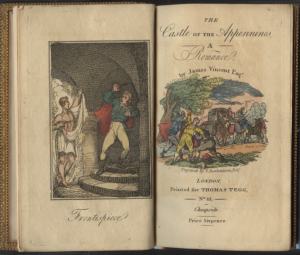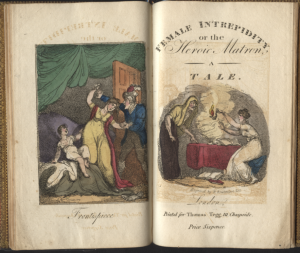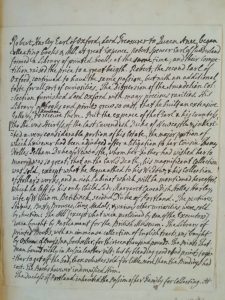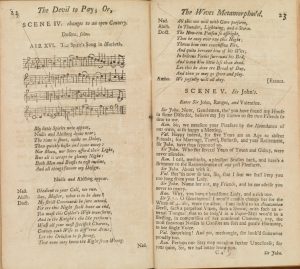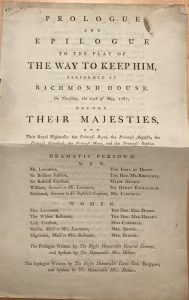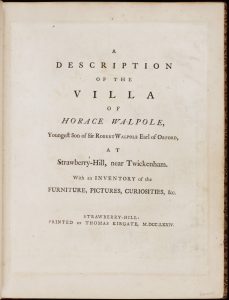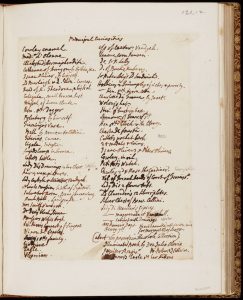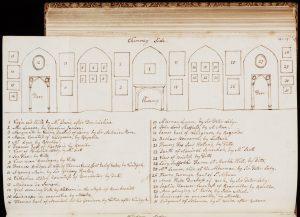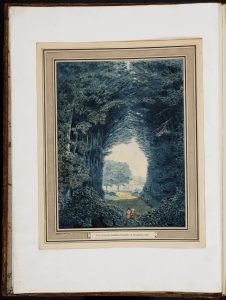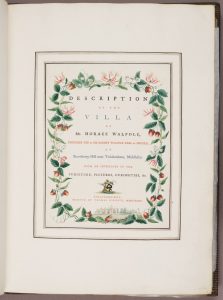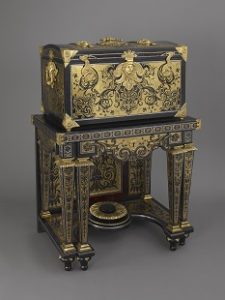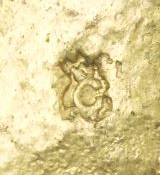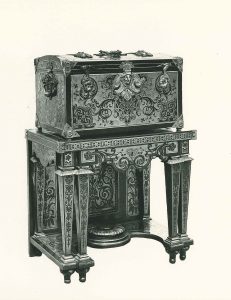Choice 19: Cole’s Copy of “The Castle of Otranto”
by Wilmarth S. Lewis
“When in March 1925 I went to London on my first Walpolian trip Chauncey Tinker, who had also just begun to collect, asked me to get him a first edition of The Castle of Otranto. ‘Any copy will do–a nice one of course’ He paused, ‘and you may have the copy Walpole gave to William Cole.’ He picked on that one because Walpole’s two letters about how he wrote the book were written to Cole, his chief antiquarian correspondent.
“Maggs had a nice copy of the first Castle of Otranto, which I asked them to put with my books and to send Tink the next one they got. I justified this greediness by thinking, ‘Tink doesn’t collect Walpole and I do.’ Fortunately, better behaviour saved me from what would have been an agonizing mistake, for on getting back to Farmington after giving the book to Tink I found a letter from Maggs that began, ‘We think you will be interested in a copy of The Castle of Otranto that has just come in. 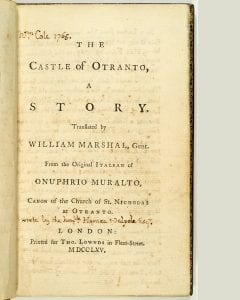 It is the copy Walpole gave William Cole.’ Cole wrote his name and “1765” on the title-page and below Walpole’s pseudonym, ‘Onuphrio Muralto, Canon of the Church of St Nicholas at Otranto,’ he added, ‘Wrote by the honble Horace Walpole, Esq.’ He also transcribed Walpole’s two letters to him about writing the book. In the first one Walpole wrote, ‘If you will tell me how to send it, and are partial enough to me to read a profane work in the style of former centuries, I shall convey to you a little story-book, which I published some time ago, though not boldly with my own name, but it has succeeded so well, that I do not any longer entirely keep the secret: does the title, The Castle of Otranto, tempt you?’ Two weeks later Walpole added,
It is the copy Walpole gave William Cole.’ Cole wrote his name and “1765” on the title-page and below Walpole’s pseudonym, ‘Onuphrio Muralto, Canon of the Church of St Nicholas at Otranto,’ he added, ‘Wrote by the honble Horace Walpole, Esq.’ He also transcribed Walpole’s two letters to him about writing the book. In the first one Walpole wrote, ‘If you will tell me how to send it, and are partial enough to me to read a profane work in the style of former centuries, I shall convey to you a little story-book, which I published some time ago, though not boldly with my own name, but it has succeeded so well, that I do not any longer entirely keep the secret: does the title, The Castle of Otranto, tempt you?’ Two weeks later Walpole added,
“I had time to write but a short note with The Castle of Otranto, as your messenger called on me at four o’clock as I was going to dine abroad. Your partiality to me and Strawberry have I hope inclined you to excuse the wildness of the story. You will even have found some traits to put you in mind of this place. When you read of the picture quitting its panel, did not you recollect the portrait of Lord Falkland all in white in my gallery? Shall I even confess to you what was the origin of this romance? I waked one morning in the beginning of last June from a dream, of which all I could recover was, that I had thought myself in an ancient castle (a very natural dream for a head filled like mine with Gothic story) and that on the uppermost bannister of a great staircase I saw a gigantic hand in armour. In the evening I sat down and began to write, without knowing in the least what I intended to say or relate. The work grew on my hands, and I grew fond of it—add that I was very glad to think of anything rather than politics—In short I was so engrossed with my tale, which I completed in less than two months, that one evening I wrote from the time I had drunk my tea, about six o’clock, till half an hour after one in the morning, when my hand and fingers were so weary, that I could not hold the pen to finish the sentence, but left Matilda and Isabella talking, in the middle of a paragraph. You will laugh at my earnestness, but if I have amused you by retracing with any fidelity the manners of ancient days, I am content, and give you leave to think me as idle as you please.
“This last was also addressed to us.
“Cole transcribed verses ‘To the honourable and ingenious Author of the Castle of Otranto,’ that had appeared in the St James’s Chronicle.
Thou sweet Enchanter! at whose nod
The aery train of phantoms rise:
Who dost but wave thy potent Rod,
And marble bleeds and canvas sighs.
By thee decoy’d, with curious Fear
We tread thy Castle’s dreary Round:
Though horrid all we see, and hear,
Thy Horrors charm, while they confound.
Full well hast thou persued the Road,
The magic Road thy master laid;
And hast, with grateful skill, bestow’d
An off’ring worthy of his shade.
Again his manners he may trace,
Again his characters may see,
In soft Matild, Miranda’s grace,
And his own Prospero in Thee.
“This must have given Walpole great pleasure, for he said in the preface to the second edition of the book that Shakespeare was his model and he championed Shakespeare against Voltaire.”
Lewis continues with commentary about the decline of Shakespeare’s reputation in the eighteenth century and Walpole’s freely borrowing from the bard in the Castle of Otranto.
“The easy runner-up in this Choice is John Carter’s water-color drawing that Walpole described in ‘More Additions’ to the ’84 Description, ‘Procession in the Castle of Otranto, in water-color by John Carter.’ Carter added to this in the copy of the Description that Walpole bequeathed him and that is now at Farmington, ‘Was paid for it 20 guineas.’ On the back of the drawing Carter wrote, ‘Entry of Frederic into the Castle of Otranto, John Carter, inv. and del., 1790’ and he showed it at the Royal Academy exhibition of that year. Walpole’s willingness to pay such a large sum for a water-color drawing proves his continuing affection for the book. He chose Carter to illustrate it because Carter was an antiquarian, the author of Specimens of the Ancient Sculpture and Painting now remaining in this Kingdom, 1786, which he dedicated to Walpole. He wrote, ‘[I] first found in you a Patron. Your kind encouragement gave wings to my ambition to continue their [the Specimens’] publication, and under your Auspices, and the Public’s generous Assistance, I have been able to bring to a Conclusion the first Volume: which with Gratitude and Respect I dedicate to you, as some acknowledgment for the great obligations conferr’d on, Sir, Your very much obliged and faithful humble Servant, John Carter. Nov. 1786.’ Its frontispiece, in which Edward the Third and his family attended by warriors, courtiers, etc., makes a regal entrance into a courtyard, foreshadows Frederic’s entry into the courtyard of Otranto,'”
Lewis quotes the passage from the Castle of Otranto in which Frederic’s entry is described.
“How to get all this on a sheet of 23 by 19 inches would have daunted a lesser Goth 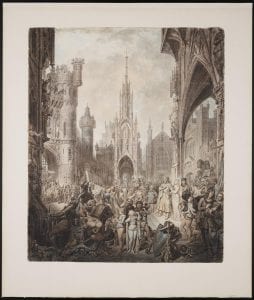 than Carter, but he managed it beautifully. Frederic’s retinue that has already arrived can be seen riding and marching into the distant parts of the castle that had been inspired by King’s College Chapel and an Eleanor Cross (Carter ignored Walpole’s hint in his second preface that the Castle was Strawberry Hill). Walking beside Frederic is his beadsman telling his beads; behind may be glimpsed the fifty footguards with drums and trumpets. Immediately in front of him are men (hardly a hundred) carrying the great sword, with Frederic in full armor, visor down, lance at rest, entering on a superbly caparisoned horse. Gazing at him from a dias across the courtyard is Manfred, the villain, understandably perturbed, with Isabella, Frederic’s daughter and the heroine of the tale, and Friar Jerome who is, I think, a portrait of Horace Walpole himself. Behind Manfred are the plumes of the giant helmet that crushed, no one knew how, Isabella’s betrothed, the fifteen-year-old sickly Conrad, Manfred’s only child. In the foreground, guarded by armed men with armor and weapons, is the castle’s orchestra playing away. It includes a blind harpist, a bearded man thumping Turkish tabors, another man with a tuba, and two graceful girls, scantily clad, one of whom is playing a two-horned instrument, the other striking a triangle. Above and beyond the gate and drawbridge are towers inspired by German castles. I haven’t begun to do justice to the drawing, but I hope I’ve suggested that it is the quintessence of the Gothic Revival and deserving of serious attention.
than Carter, but he managed it beautifully. Frederic’s retinue that has already arrived can be seen riding and marching into the distant parts of the castle that had been inspired by King’s College Chapel and an Eleanor Cross (Carter ignored Walpole’s hint in his second preface that the Castle was Strawberry Hill). Walking beside Frederic is his beadsman telling his beads; behind may be glimpsed the fifty footguards with drums and trumpets. Immediately in front of him are men (hardly a hundred) carrying the great sword, with Frederic in full armor, visor down, lance at rest, entering on a superbly caparisoned horse. Gazing at him from a dias across the courtyard is Manfred, the villain, understandably perturbed, with Isabella, Frederic’s daughter and the heroine of the tale, and Friar Jerome who is, I think, a portrait of Horace Walpole himself. Behind Manfred are the plumes of the giant helmet that crushed, no one knew how, Isabella’s betrothed, the fifteen-year-old sickly Conrad, Manfred’s only child. In the foreground, guarded by armed men with armor and weapons, is the castle’s orchestra playing away. It includes a blind harpist, a bearded man thumping Turkish tabors, another man with a tuba, and two graceful girls, scantily clad, one of whom is playing a two-horned instrument, the other striking a triangle. Above and beyond the gate and drawbridge are towers inspired by German castles. I haven’t begun to do justice to the drawing, but I hope I’ve suggested that it is the quintessence of the Gothic Revival and deserving of serious attention.
“It was bought at the Strawberry Hill sale by the Rev. Horace Cholmondeley and descended to his great-grandson, the late General Sir Henry Jackson, a Dorset neighbor of Owen Morshead who brought us together. General Jackson very kindly let me have not only the drawing, but one of Walpole’s copies of Watteau mentioned in Choice 3 and his annotated copy of McArdell’s print after Walpole’s portrait by Reynolds, which is Choice 26. The three pieces hang in our side hall and are a daily reminder of the General and Owen Morshead as well as of Horace Walpole, John Carter, and Watteau.”
Lewis quotes several contemporary and subsequent reviews of the Castle of Otranto.
“The continuing success of The Castle of Otranto is one of the phenomena of English literature. There have been ninety editions of it, fifteen of them in this century including a recent one of 50,000 copies in Russia. The first of seven American editions was published in New York in 1801; later nineteenth-century editions appeared in Philadelphia and Hartford; three editions have been published in France, two in Germany, four in Italy where Bodoni of Parma printed the finest in 1791. Walpole’s copies of it and of the handsome 1795 translation in London are at Farmington in morocco bindings worthy of them. Two of the five or six printed by Bodoni on vellum are also at Farmington.
“In my Introduction to the edition published by the Oxford University Press in 1964 I quoted, as commentators on the Castle of Otranto always do, Walter Scott’s praise of the book in his 1811 edition. He called it ‘remarkable not only for the wild interest of the story, but as the first modern attempt to found a tale of amusing fiction upon the basis of the ancient romance of chivalry,’ and he conceded to Walpole the applause ‘which cannot be denied to him who can excite the passions of fear and of pity.’ I am struck by his speaking of ‘the wild interest of the story,’ for I confess, quite quietly here, I have never field any fear or pity in it; instead, I marvel how such a lucid and entertaining writer as Horace Walpole could have written so confused and clumsy a book. Gray’s and his friends’ delight in it came, I think from the novelty of the book’s setting, its pseudo-mediaeval speech, and its supernatural events. Richardson, Fielding, and Smollett had nothing like that. I am convinced by Henry James’s transitions to the supernatural, but I find Walpole’s ludicrous. Alfonso sighing and stepping out of his portrait is arresting, but when Manfred cries, ‘Lead on! I will follow thee to the gulph of Perdition,’ I do not yield to ‘the style of former centuries,’ but find Alfonso his own parody. Carter’s drawing, on the other hand, leads us into a magical courtyard with Horace Walpole as Friar Jerome watching us from the court and is welcomed by the Otranto heralds and orchestra. When Walpole was writing his letters he was talking easily to his correspondents, but when he wrote his novel he was being ‘literary.’ The Castle of Otranto must continue to be read by students as a landmark of English literature, yet it is not, I think, for others.
“The eighteenth century’s high regard for it is shown not only by the eighteen editions published then, but by contemporary illustrations of the story. There are thirty-four of them at Farmington bound in various copies of the book. Among them are two that suggest the artists failed to understand that Alfonso stepped off the canvas and down on the floor for they brought the whole picture down, frame and all. Much the best of these illustrations are four by Bertie Greatheed, aged fifteen, of Guy’s Cliff, Warwick. Walpole wrote his father,
“I have seen many drawings and prints made from my idle—I don’t know what to call it, novel or romance—not one of them approached to any one of your son’s four—a clear proof of which is, that not one of the rest satisfied the author’s ideas—It is as strictly, and upon my honour, true, that your son’s conception of some of the passions has improved them, and added more expression than I myself had formed in my own mind; for example, in the figure of the ghost in the chapel, to whose hollow sockets your son has given an air of reproachful anger, and to the whole turn of his person, dignity. Manfred in the last scene has an uncertain horror, that shows he has not yet had time to know what kind of agony he feels at what he has done. Such delineation of passions at so very youthful a period, or rather in boyhood, are indubitable indications of real genius, and cannot have issued from the instructions or corrections of a master.
“Was there any way, Walpole asked, in which he might secure the originals or copies of them?  The rest of the correspondence is missing, but the drawings–which make one think of Blake–were bound by Walpole in his copy of Bodoni’s 1791 edition published in London by J. Edwards and are now at Farmington. These four drawings are far superior to the efforts of Greatheed’s older amateur contemporaries and we join Walpole in lamenting the early death of the outstanding amateur of his time.”
The rest of the correspondence is missing, but the drawings–which make one think of Blake–were bound by Walpole in his copy of Bodoni’s 1791 edition published in London by J. Edwards and are now at Farmington. These four drawings are far superior to the efforts of Greatheed’s older amateur contemporaries and we join Walpole in lamenting the early death of the outstanding amateur of his time.”
Lewis, Wilmarth S. Rescuing Horace Walpole. New Haven and London: Yale University Press, 1978.
To see the full chapter from Rescuing Horace Walpole called “Choice 19: Cole’s Copy of “The Castle of Otranto”” download or expand the link here:
 Loading...
Loading...
N.B. a mini-conference focused on The Castle of Otranto was held at the Lewis Walpole Library on November 10, 2017 and the morning session and afternoon session are available on Yale’s YouTube channel.

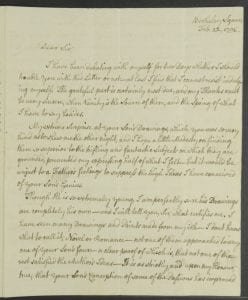
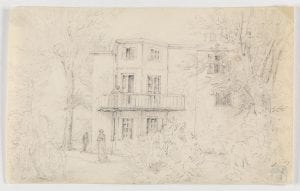

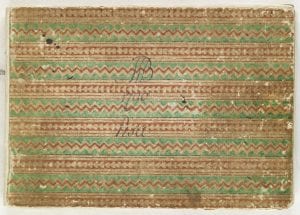
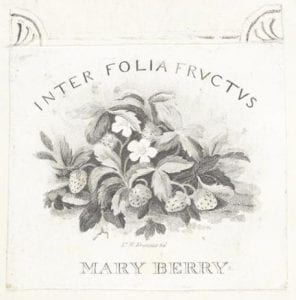
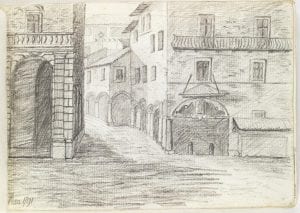
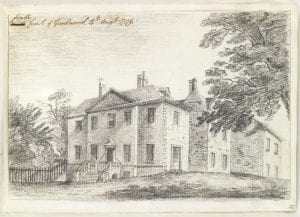
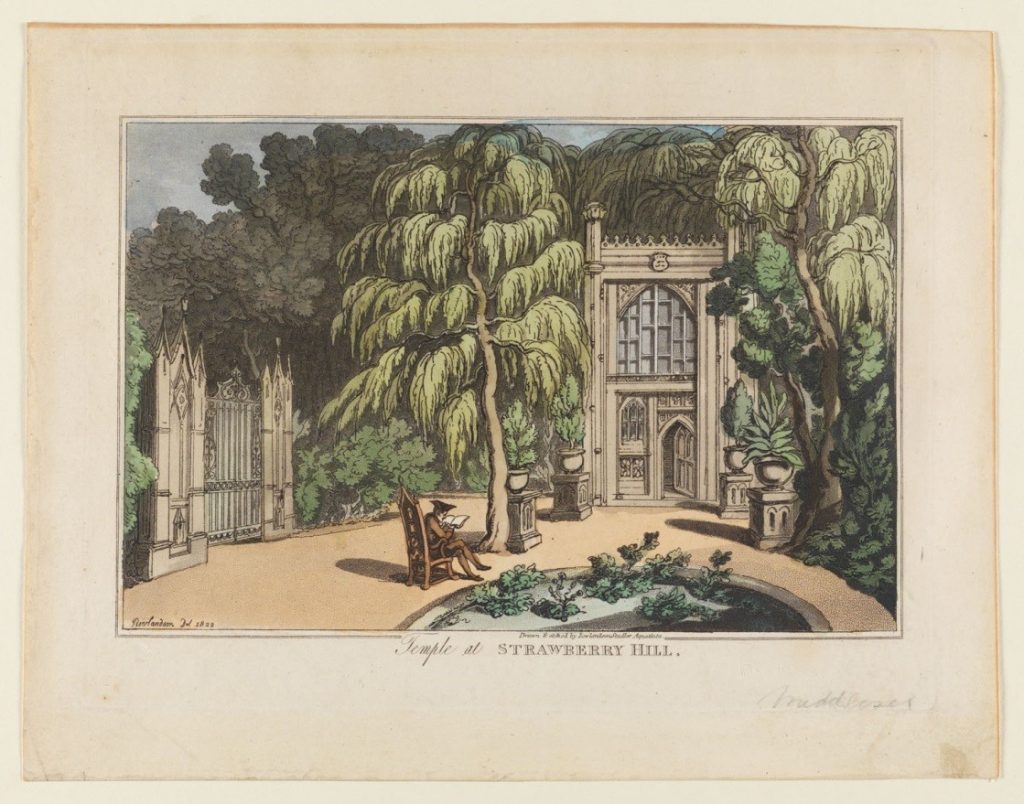

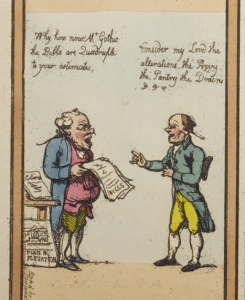

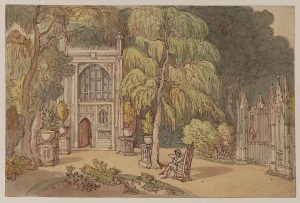

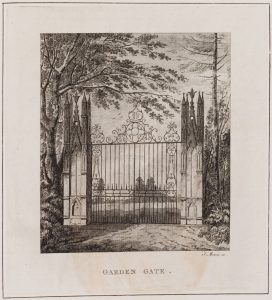

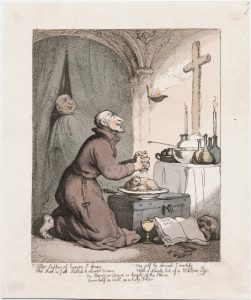

![Drawing by Rowlandson [Strawberry Hill from the West]](https://campuspress.yale.edu/walpole300/files/2018/02/Strawberry-Hill-from-the-west-172voak-300x192.png)




